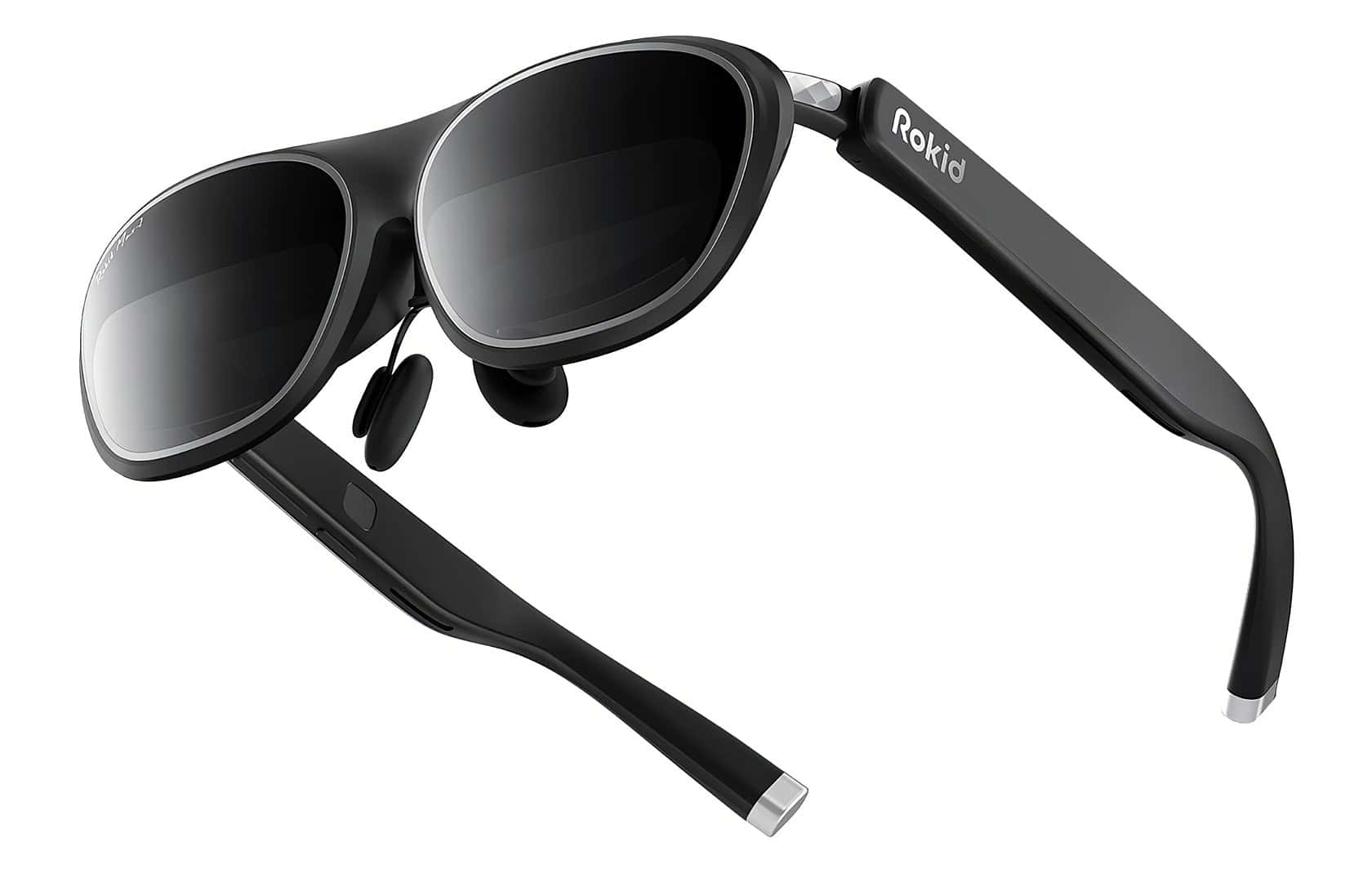Tired of squinting at your smartphone or tablet during long gaming or movie sessions? The Rokid Max 2 Review: these sleek AR glasses promise OLED visuals equal to a massive 360-inch screen.
We’ll give you a clear look at its design, performance in real-world apps and games, and help you decide if it’s worth the hype. Read on for our honest take.
Key Takeaways
Rokid Max 2 AR glasses come with dual micro-OLED screens—each eye gets crisp 1920 x 1080 resolution—giving you a giant virtual 360-inch display at a smooth 120 Hz refresh rate.
They weigh only 75 grams, feature durable titanium alloy hinges, and feel comfy for long stretches. Plus, you can adjust the lenses from -6.00D to +1.00D if you usually wear glasses.
Brightness hits up to 3000 nits and lets you choose from six brightness levels. Color performance covers 106% sRGB, giving vibrant visuals—but the built-in speakers sound thin, and audio tends to leak more at louder volumes.
The Rokid Max 2 costs $359 (or $399 if bundled with a wireless adapter), connects easily via USB-C to your phone, tablet, laptop, or gaming console, and includes a 30-day hassle-free return window.
Visual quality makes these glasses great for movies, games, and work, yet the device sometimes randomly disconnects from the Rokid Station, and there’s no automated shade adjustment under bright lights, which can be inconvenient.
Table of Contents
Rokid Max 2: Overview of Key Features
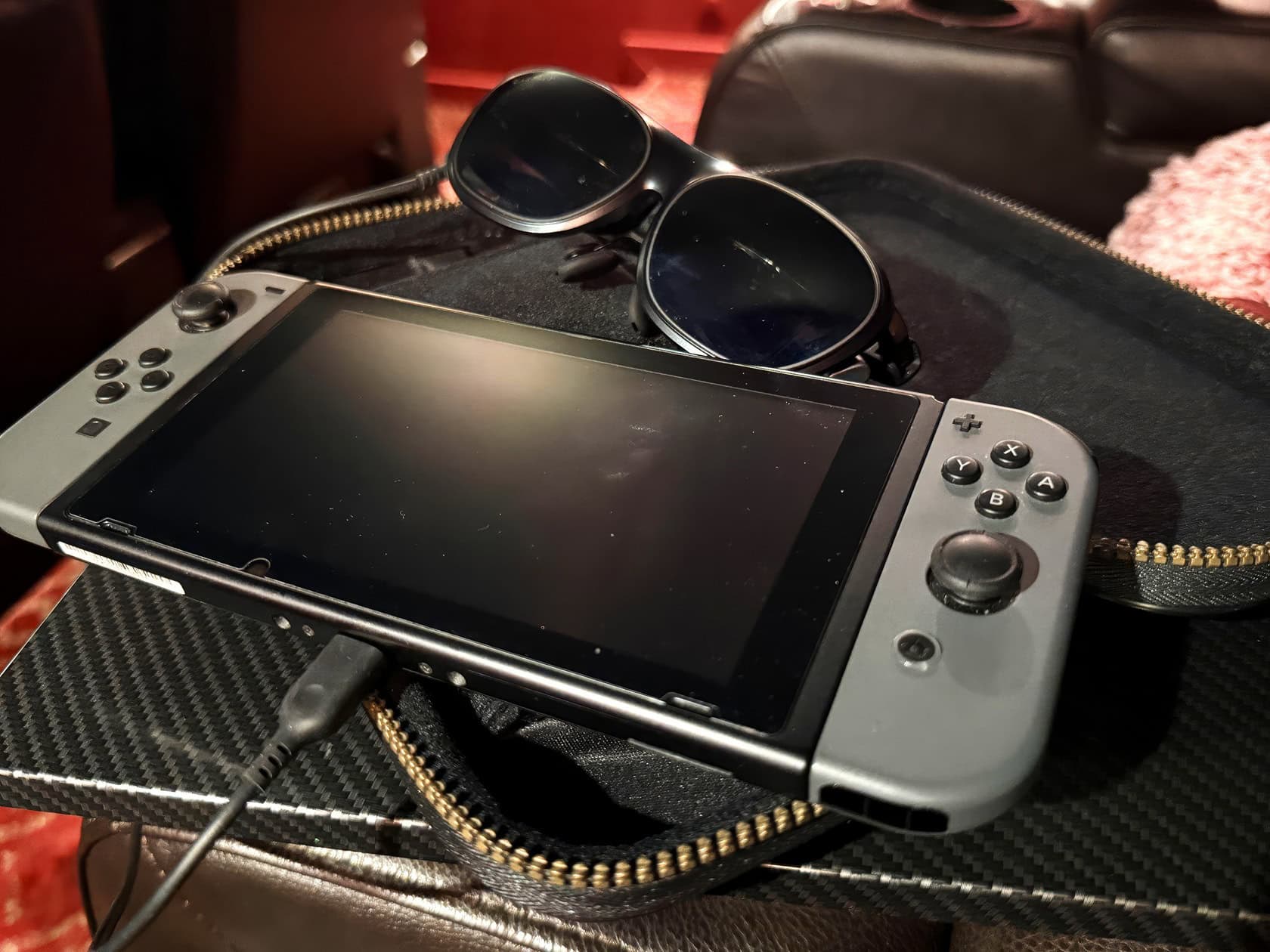
The new Rokid Max 2 AR Glasses hit the market on January 9, 2025, offering geeks and gadget lovers dazzling OLED visuals wherever they go. These sleek smart glasses boast dual micro-OLED displays with a crisp resolution of 1920 x 1080 pixels per eye; imagine having your own private cinema with a virtual screen size reaching up to an amazing 360 inches at just over 30 feet away!
Gaming fans will love the super-smooth refresh rate of up to 120 Hz and brightness levels that peak at an impressive 3000 nits, making games from Nintendo Switch or content streamed from Amazon Prime Video truly pop.
Alongside handy features like diopter adjustment wheels, prescription lens inserts for nearsighted and farsighted users, built-in audio for immersive sound without headphones or earbuds, and versatile USB-C connectivity perfect for pairing with smartphones (Android phones as well as iPhones), tablets such as iPads, PCs, laptops—and even gaming handhelds—the Max 2 promises excitement right out of its box.
Is Rokid Max 2 only style—or real substance?
Let’s check out how these shades fare in design and build quality.
Design and Build Quality
The Rokid Max 2 sports a slimmer profile than its predecessor, making it feel less bulky on your face during movie marathons. The glasses weigh just 75 grams – lighter than many standard spectacles – which helps prevent the nose fatigue common with other AR headsets.
Sleeker and Lightweight Design
Rokid Max 2 comes in an appealing dark gray color that grabs attention without looking flashy or loud. Right away, I noticed how much lighter these AR glasses felt compared to other head-mounted displays I’ve worn before.
At just 75 grams, they won’t tire you out, even during extended gaming sessions or lengthy movie nights. The hinges—made from titanium alloy—provide strength without adding unnecessary weight, a smart choice any tech enthusiast will value.
They move smoothly yet fit snugly against your temples, offering steady support without pressure.
After my first week with the Rokid Max 2, comfort stood out as a major plus. The glasses rest easily on my face, never pressing too hard against my ears or nose. Unlike heavier AR devices I’ve tested that cause discomfort after only an hour, I wore this pair comfortably throughout a three-hour flight.
Being so lightweight truly matters if you plan on wearing augmented reality glasses for hours at a time. Its slim build and subtle design also make the Rokid Max 2 appear more like everyday eyewear than high-tech gear—a bonus if style matters to you.
Comfort for Extended Use
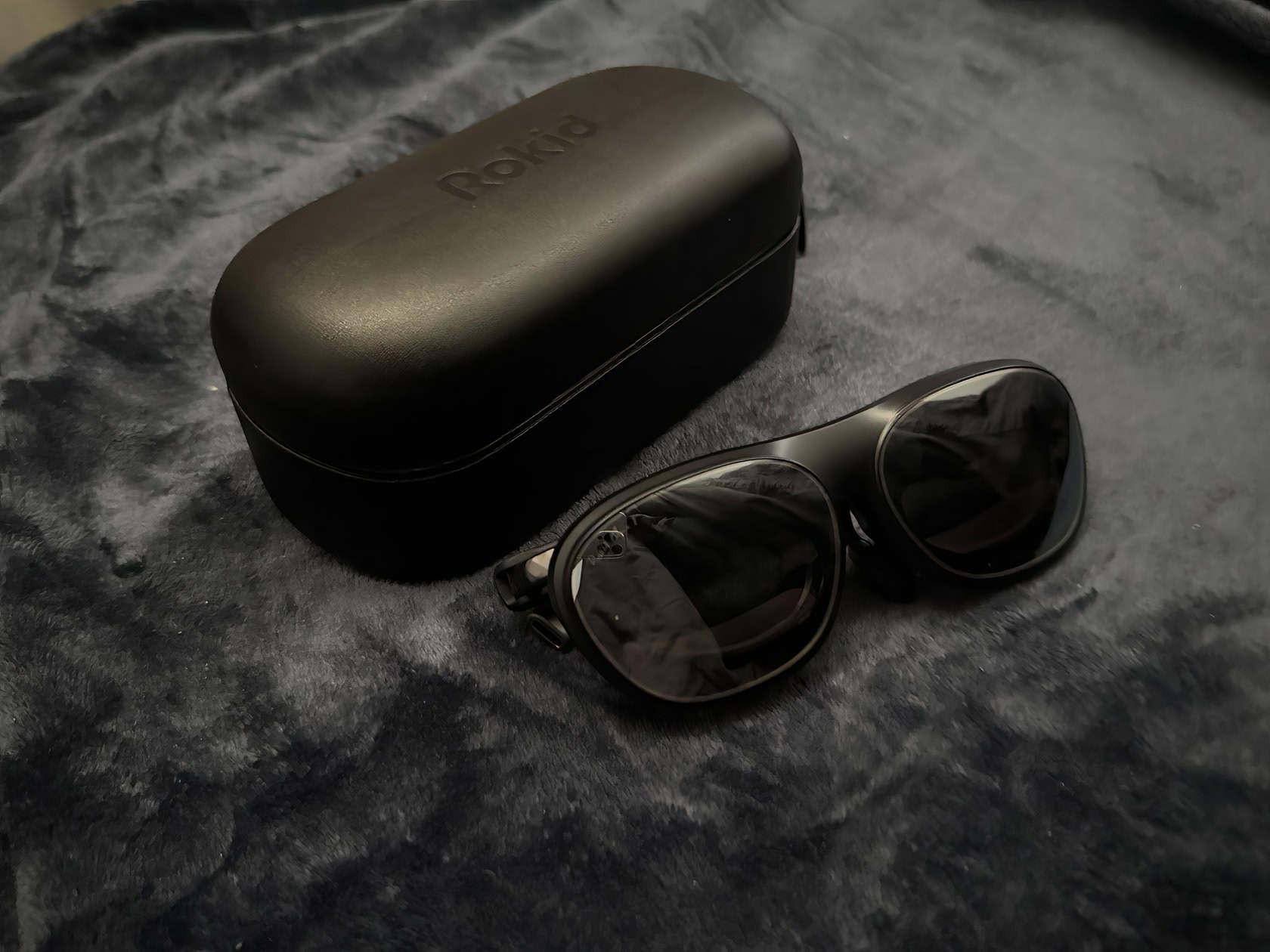
The Rokid Max 2 stands out for more than its stylish appearance—it keeps comfort front and center for longer viewing sessions. Adjustable air nose pads make a huge difference, especially if you hate the annoying pinched-nose feeling after wearing glasses for an hour or so.
These pads rest lightly on your face, easing pressure points, often troublesome with other AR eyewear. Soft, flexible temple arms also add a nice touch, gently hugging your head instead of digging in like rigid models tend to do.
The true test of AR glasses isn’t just the display quality, but whether you can forget you’re wearing them at all.
Diopter adjustment wheels become an instant plus for anyone who usually wears glasses. Simply dial the focus from -6.00D up to +1.00D—no need to slip regular prescription specs underneath.
This handy feature eases eye strain, perfect for long gaming marathons or extended binge-watching on the OLED display. While some gadgets can feel heavy and tiresome after just half an hour of use, the Max 2 remains so comfortable that you might easily lose track of having high-tech gear on your face.
OLED Display Performance
The Rokid Max 2 shines with its stunning OLED display that brings movies and games to life right before your eyes. The screen offers deep blacks and vibrant colors that make virtual screens pop with a clarity that rivals physical monitors.
Brightness and Color Accuracy
Rokid Max 2 packs a punch with brightness levels reaching up to 3000 nits—bright enough to make visuals pop, even in rooms filled with natural light. You can choose from six brightness modes, easily adjusting the screen to your comfort without any strain.
Colors truly shine with an impressive 106% sRGB coverage, giving accurate, vivid images perfect for movies or gaming sessions. Thanks to the vibrant OLED display, even tiny text looks sharp and easy-to-read, satisfying detail-oriented users who crave excellent visuals—especially compared to VR.
Audio matters just as much for that full, immersive experience, right alongside these crisp visuals. Let’s explore how well the built-in speakers perform in real-life settings.
Clarity and Edge Sharpness
The Max 2 brings vibrant colors and sharp, clear visuals right to your eyes. Its impressive resolution—1920 x 1080 pixels per eye—delivers crisp graphics with almost no edge blur.
Even tiny text stands out clearly, ideal for reading documents or browsing through websites. And while a 50-degree field of view may sound limited compared to other AR options, the narrower angle keeps visuals sharp from edge to edge.
During testing, I didn’t notice any “screen door effect” on the OLED display—something that’s common on many wearable screens. Games and videos maintain sharp details all the way out to the borders.
Such clear edges help make the Max 2 suitable both for entertainment and serious work tasks. Plus, the display is flicker-free—great if you’re planning extended use, cutting down on eye fatigue significantly.
Graphics appear smooth with clean lines, sharp color shifts, and vibrant detail—creating a visual experience that’s truly captivating.
Audio Experience
The Rokid Max 2 delivers rich, clear sound that makes movies and games feel more real. The built-in speakers pump out decent audio without the need for extra headphones, though you might want them for truly private viewing.
Built-in Audio Quality and Immersion
Rokid Max 2 comes equipped with private directional speakers that deliver clear audio, perfect for personal viewing without bothering others. Dialogue and general media sound crisp enough, but audio depth and bass fall short—action scenes and music tracks might disappoint serious audio fans hoping for more impact.
On the plus side, noise-canceling microphones built into the glasses help make voice commands and phone calls clearer—a handy extra for those who need productivity on the go. One small issue: at higher volumes, sound tends to leak out, letting people close by overhear what’s playing—a noticeable trade-off for anyone wanting privacy from wearable devices.
To solve this, your best choice might be connecting external headphones through the USB-C port—giving you richer sound and the privacy you’re after.
Compatibility and Connectivity

The Rokid Max 2 plays nice with almost any device through USB-C, DisplayPort, and mini HDMI options. You can link it to your phone, laptop, or even the Rokid Station for a wider range of Android apps and streaming services.
Device Pairing Options
Rokid Max 2 smart glasses easily connect to your devices for work, gaming, or watching content. They support many devices, so you just plug in and start enjoying.
- Quickly connect laptops or phones that use USB-C ports with a simple plug-and-play cable supporting DisplayPort.
- Easily pair with Android phones to stream videos, watch movies, or enjoy mobile games on your own virtual big-screen experience.
- Connect directly with your gaming console—enjoy your favorite games privately, without taking over the family TV.
- For older devices missing USB-C, use a simple HDMI to USB-C adapter, priced at just $29, to keep everything working seamlessly.
- Hook up to laptops easily, making these glasses your private second monitor—perfect for productivity at the coffee shop or relaxing entertainment at home.
- Integrate smoothly with Rokid Station for added controls, more features, and smooth access to your media.
- Mini HDMI port lets you quickly plug in smaller devices, like digital cameras, for immediate, clear viewing of your shots or videos.
- Connect directly with Steam to play PC games and enjoy immersive visuals on the crisp OLED screen.
- Enjoy comfortable viewing angles—even slight head movements won’t affect clear and sharp images on your glasses’ displays.
- Flicker-free screens keep your eyesight comfortable and relaxed during long hours of movie streaming or intense game sessions.
Rokid Station Integration
Adding the Station 2 to the Rokid Max 2 glasses delivers powerful upgrades, like 3DoF tracking and easy multitasking. I connected my glasses to the lightweight, pocket-sized hub (just 148 grams), and instantly got a larger, clearer virtual display.
Its 5000mAh battery can run about five hours straight—ideal length for streaming full movies or handling longer work sessions comfortably. Plus, the handy reverse charging saved my phone from dying on a recent road trip—pretty convenient, actually.
With Station 2, simple AR glasses become a complete, portable entertainment setup. It easily connects through USB-C or display port without any annoying delays or lag. The AR Lite Kit Bundle that includes the Station 2 is priced reasonably at $389, considering the total package you get.
Next, we’ll check out how Max 2 glasses handle daily tasks and real-life use beyond basic technical details.
Performance in Real-World Use
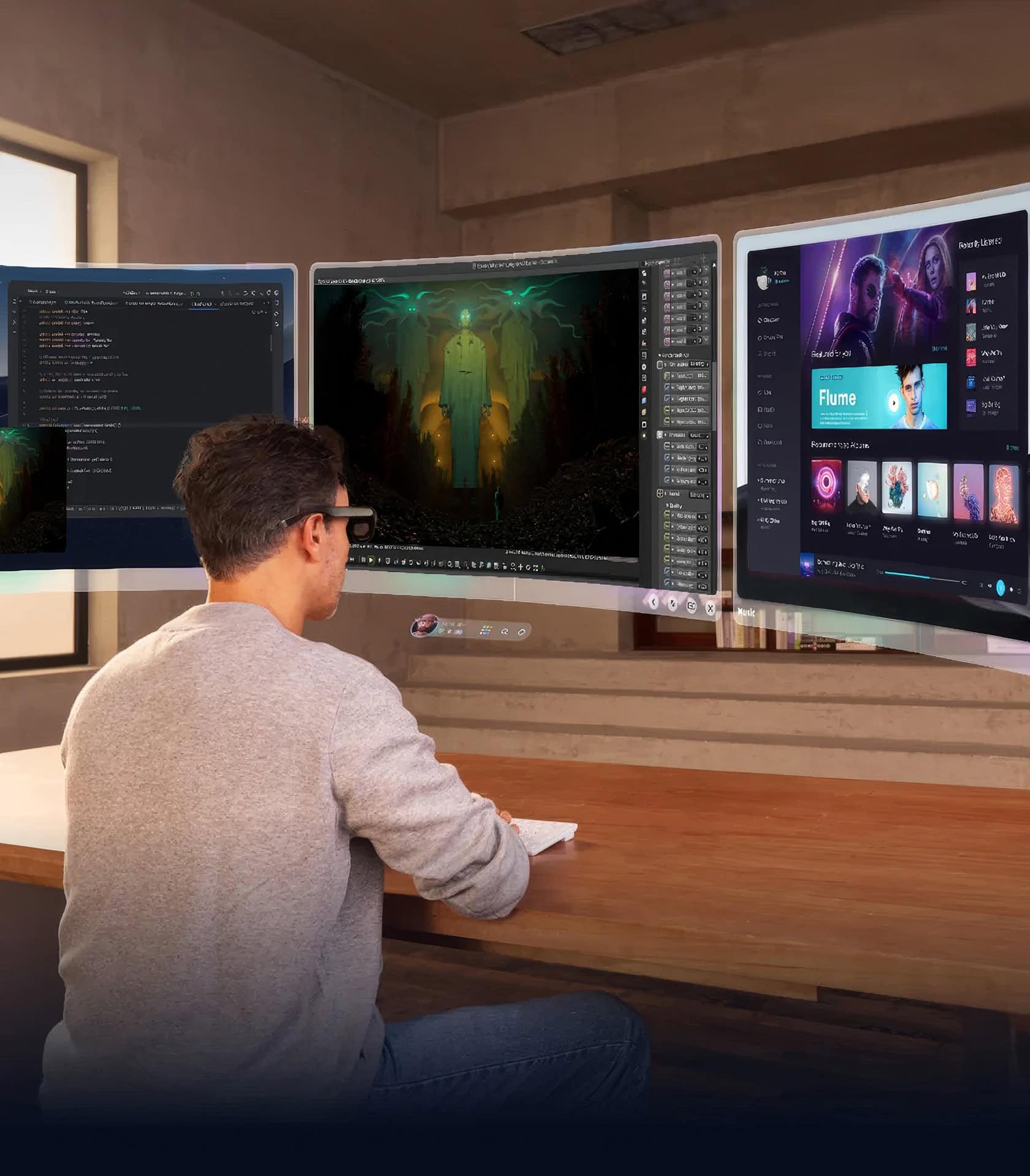
The Rokid Max 2 shines in daily use with smooth performance across games and movies on multiple devices. I tested it with my PlayStation and Android TV apps, and the OLED display made everything pop with zero lag or flicker issues.
Gaming and Entertainment
Gaming is where the Rokid Max 2 truly stands out. I tried a handful of fast-action games and saw no lag at all, thanks to the silky-smooth 120 Hz refresh rate. On its virtual 360-inch screen, gameplay feels insanely immersive—something regular monitors just can’t deliver.
Its OLED display brings deep shadows to life in scary games, and racing titles look crisp and vibrant, right up to the edges.
Movie lovers can enjoy a cinema-like experience, too, minus the awkward bulk of standard VR headsets. I streamed videos through different apps on my connected device, finding the colors vivid and lifelike.
The built-in speakers work fine for everyday watching, but serious gamers might prefer pairing their own headphones, to fully dive into their games. Multiple users praised the Max 2’s gaming abilities in online customer feedback, highlighting how the expansive viewing area significantly boosts gaming fun.
Productivity Applications
Rokid Max 2 glasses aren’t just for entertainment—they’re surprisingly handy for serious productivity tasks too. For example, connecting the glasses to the AR Lite Kit with Station 2 instantly creates a workspace right in front of your eyes.
I tried several office apps through this setup and noticed smooth, lag-free performance every single time. Plus, the built-in eye comfort certification from TUV Rheinland made longer sessions much gentler on my eyes than staring at typical screens.
These wearables are perfect for professionals needing a portable yet private display on the move. You can easily edit documents, reply to emails, or review spreadsheets without leaning over a cramped phone screen.
The expansive wide-angle view provides plenty of room to tackle detailed tasks comfortably. Users with nearsightedness even report working comfortably by wearing these glasses over their regular prescription lenses.
With a simple USB-C connection, setup is quick and easy with most modern tablets and laptops. This makes the Max 2 glasses especially handy for digital nomads and remote-working pros who need convenience without sacrificing comfort.
Pros and Cons of Rokid Max 2
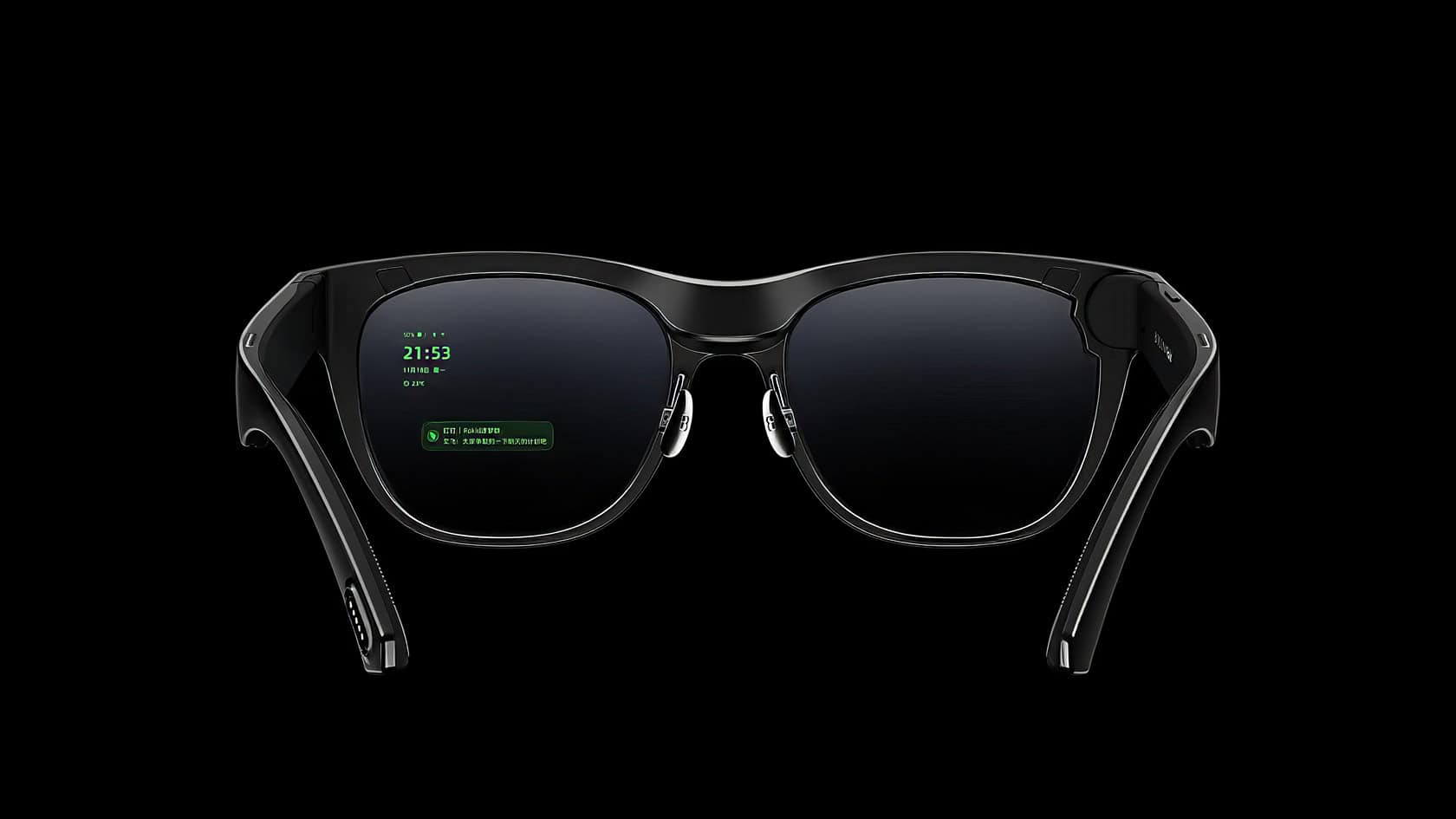
The Rokid Max 2 brings both stellar features and a few drawbacks worth noting before you buy. Let’s break down what makes these AR glasses shine and where they still need work.
Key Advantages
Rokid Max 2 stands out with its stunning OLED display, offering crystal-clear visuals and supporting HDCP content—perfect for binge-watching your favorite series or streaming the latest movies.
Weighing only 75 grams, they’re so light you’ll hardly feel them, even during long gaming sessions or extended movie nights. With strong yet lightweight titanium alloy hinges, the Max 2 avoids common problems, like frames snapping easily, that trouble other AR glasses.
Also handy are the six adjustable brightness settings, easily matching your viewing comfort to any lighting—from a pitch-dark bedroom to a sunny backyard. This flexibility makes the glasses great not just for gaming, but also for everyday productivity tasks, without tiring your eyes.
Connecting your devices is a breeze, thanks to the simple USB-C compatibility—phones, tablets, laptops—you name it, it works seamlessly.
Areas for Improvement
The Max 2 from Rokid disappoints in some important ways, especially if you’re really into tech gadgets. During my tests, I found serious sound leakage issues—the kind that lets folks nearby easily hear whatever you’re listening to, especially at louder volumes.
That’s a bit awkward and can definitely compromise your privacy in public.
Another downside is the absence of built-in electrochromic lenses, meaning you’ll have no automatic tint adjustment in sunny or brightly-lit places. You’re stuck dealing with glare manually, which can get annoying fast.
Connectivity with the Rokid Station proved especially troublesome. In my extended sessions playing games or watching movies, the connection randomly dropped multiple times. Losing connection repeatedly really kills the fun, disrupting any sense of immersion.
These kinds of issues become pretty obvious when comparing the Max 2 against competitors like the Xreal Air 2 or the Viture XR Pro—both strong rivals in the AR headset market.
Pricing and Value for Money
Rokid Max 2 just launched at $359—offering solid value if you love new tech. For a bit more money, at $399, you get the glasses bundled with a wireless adapter for extra connectivity.
Shoppers looking to stretch their dollar might prefer the AR Joy 2 bundle at $389, which pairs Max 2 glasses with the Rokid Station device. Buying the bundle saves you cash compared to purchasing each separately.
Plus, every purchase comes with a 30-day return window and a guaranteed full refund, removing risk for new buyers.
You can easily personalize your setup with optional accessories. For instance, there’s a handy HDMI-to-USB-C adapter priced at $29, great for connecting to various gadgets. Gamers might enjoy adding the gaming controller, available separately for $59, to boost control during play.
Long-term wearers may find comfort in the anti-slip strap, offered at just $19.99. With multiple options and fair prices, Rokid Max 2 stays friendly to your wallet—way less expensive than pricier competitors like Apple Vision Pro.
Final Verdict: Does Rokid Max 2 Live Up to the Hype?

The Rokid Max 2 truly shines, offering crisp OLED visuals filled with rich colors and sharp details. Movies and games suddenly feel bigger, brighter, and far more exciting than on a regular screen.
Soft temple arms and padded air nose pieces mean you can watch for hours without discomfort. Sure, the audio isn’t perfect—and you’ll have to connect through USB-C—but those small issues don’t spoil the fun.
If you’re into tech and crave a super-sized screen without lugging around heavy gear, the Max 2 delivers big-time value for its price.
People Also Ask
What makes the Rokid Max 2 different from other head-mounted displays?
The Rokid Max 2 offers flicker-free OLED visuals and an immersive, wide-angle experience. You can comfortably wear it with your existing prescription glasses. Plus, it lets you adjust settings for pupil distance, making it suitable for near-sighted or far-sighted vision.
Can I connect the Rokid Max 2 to other devices?
Absolutely—connecting is straightforward via USB-C. Want even more multimedia choices? Pair it with the Rokid Hub, or go further with the Rokid Station 2 to enhance entertainment and productivity.
Does Rokid Max 2 support apps?
Yes, it works with Google Play Store. So, you’re free to explore numerous apps—great for streaming movies or AR experiences.
How do I control the Rokid Max 2?
Navigating content is easy with the built-in touchpad. No need for extra controllers; its intuitive design keeps usage simple and seamless.
